Marcus Aurelius › Vagharshapat › Queen of Sheba » Origins and History
Articles and Definitions › Contents
- Marcus Aurelius › Who Was
- Vagharshapat › Origins;
- Queen of Sheba › Who Was
Ancient civilizations › Historical places, and their characters
Marcus Aurelius › Who Was
Definition and Origins
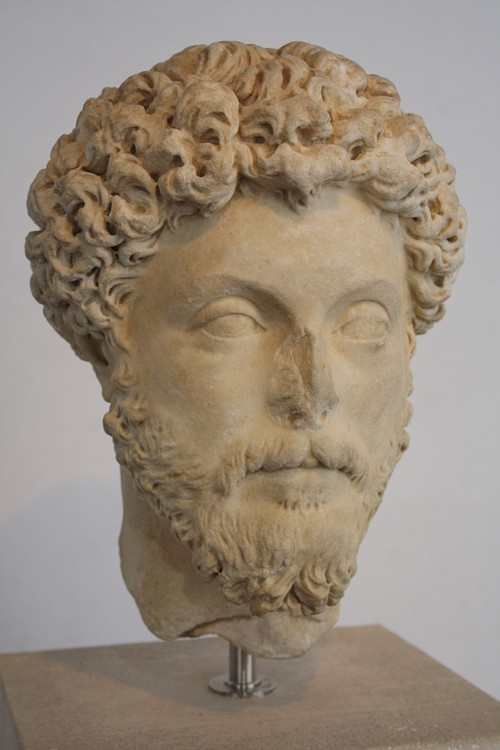
Marcus Aurelius reigned as Roman emperor from 161 to 180 CE and is best known as the last of the Five Good Emperors of Rome (following Nerva, Trajan, Hadrian, and Antoninus Pius ) and as the author of the philosophical work Meditations.He has long been respected as embodying the Platonic concept of the Philosopher King as articulated in Plato ’s Republic : a ruler who does not seek power for his own sake but to help his people. He was introduced to philosophy at a young age and his Meditations, composed while on campaign in his fifties, make clear that he held a deeply philosophical, specifically Stoic, view throughout his life.
His reign, in fact, is defined by the Stoic view and he is referred to as “the philosopher” by the later historian Cassius Dio (c. 155-235 CE) and the author (or authors) of the Historia Augusta (4th century CE), a history of Roman emperors. His Stoic outlook is expressed throughout his Meditations and his view of one's responsibility to others is made clear in a line from Book VIII.59: “People exist for the sake of one another; teach them, then, or bear with them.”
MARCUS AURELIUS CONSISTENTLY PLACED THE NEEDS OF THE PEOPLE BEFORE HIS OWN DESIRES OR VISIONS OF GLORY & WORKED FOR THE COMMON GOOD.
He lived his philosophy in both his private and public life in that he consistently placed the needs of the people before his own desires or visions of glory and worked for the common good. It is among history's ironies, however, that his reign is characterized by incessant warfare and the persecution of the new religious sect of Christianity. Even so, he successfully conducted campaigns in Germania and managed the affairs of the empire efficiently. He died of natural causes following an illness in 180 CE and was instantly deified.
In the modern-day, he is probably best known from the popular film Gladiator (2000 CE) as the father of Commodus (r.177-192 CE) whose decision to pass over his son as successor serves as the point of departure for the film's plot. Contrary to his depiction in the film, Aurelius was not killed by Commodus and, in fact, Commodus would co-rule with his father from 177-180 CE and succeeded him without opposition; though he would prove to be one of the worst rulers Rome would have to endure and his reputation suffered further by comparison with his father.
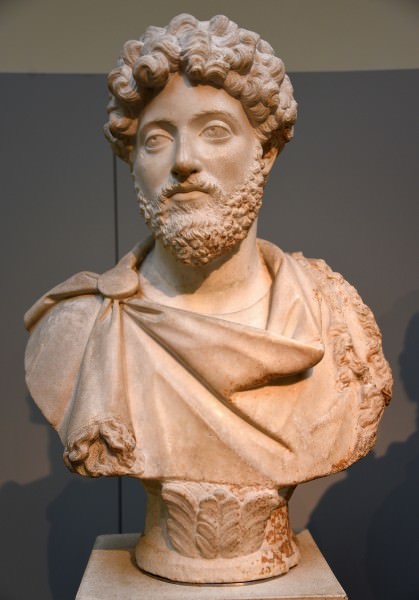
Bust of Marcus Aurelius
EARLY YOUTH
Marcus Aurelius was born in Spain on 26 April 121 CE to an aristocratic patrician family. His birth name was Marcus Annius Verus, after his father of the same name. His grandfather and great-grandfather on his father's side were senators and his mother, Domitia Lucilla (known as the minor, c. 155-161 CE), also came from a wealthy and politically connected family.Aurelius' father died in c. 124 CE and he was raised primarily by nurses and his grandfathers.
Events from his early life are suggested by comments he makes in his Meditations (especially in Book I), from correspondence between himself and his teacher Fronto, and from the Historia Augusta which, though often considered unreliable, is still cited by scholars when certain passages seem probable. Details of his younger years, therefore, are scarce but it is assumed he would have been brought up in accordance with traditional patrician practices, learned Greek at the same time he was learning Latin, and would have been groomed for a public life in rhetoric and oratory.
When he was in his early teens, around 132 CE, a teacher named Diognetus introduced him to philosophical texts. These were most likely works of the Cynic Philosophers who sought to live in the simplest way and disregarded all social conventions as artifice. Aurelius seems to have been quite impressed with this outlook as he then affected a typically Cynic lifestyle of dressing in a rough woolen cloak and sleeping on the ground or the floor of his room instead of his bed. He mentions this in Meditations Book I.6 in referencing how he chose “the Greek lifestyle – the camp-bed and the cloak” after his association with Diognetus.
HE MOST LIKELY WOULD HAVE ALSO ADOPTED THE CYNIC APPROACH TO SIMPLE, COARSE FOOD, FEW POSSESSIONS, & NEGLECT OF BASIC HYGIENE.
He most likely would have also adopted the Cynic approach to simple, coarse food, few possessions, and neglect of basic hygiene. Although it is unclear, it seems that his mother forced him to stop his philosophical pursuits and focus on what she saw as a more respectable career path.
Sometime after this, he received new tutors in oratory and rhetoric and among these were Herodes Atticus (l. 101-177 CE) and Marcus Cornelius Fronto (d. late 160's CE) whose reputations for excellence in their arts were highly respected and commanded a high price. Fronto and Aurelius would become life-long friends and both he and Atticus would exert significant influence over the young Aurelius. He was shortly after betrothed to Ceionia Fabia, daughter of the respected politician Lucius Ceionius Commodus (d. 138 CE) and sister of Aurelius' future co-emperor Lucius Verus (r. 161-169 CE).
ADOPTION BY ANTONINUS & RISE TO POWER
In 136 CE, the emperor Hadrian (r. 117-138 CE) selected Lucius Ceionius Commodus as his successor for reasons which are unclear. Commodus was married to Marcus Aurelius' aunt Faustina and it is probable that Hadrian chose Commodus as a kind of place-holder for the teen-age Aurelius who would then succeed him later. Commodus died in 138 CE, however, and Hadrian then chose Aurelius Antoninius (later known as Anoninus Pius (r. 138-161 CE) as successor with one stipulation: he had to adopt Marcus and Lucius Verus as his sons and successors. Antoninus agreed and young Marcus took the name Marcus Aurelius Antoninus and was groomed as the next emperor.
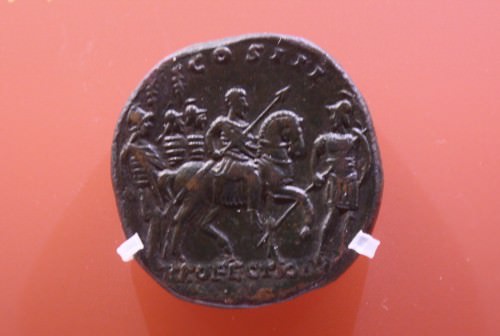
Marcus Aurelius on Campaign
Antoninus Pius was an extremely effective monarch and an important role model for his successor. Aurelius devotes a long passage of praise to his adopted father in his Meditations in which he lists the emperor's impressive qualities (Book I.16).Antoninus had Aurelius' betrothal to Ceionia Fabia annulled and arranged a marriage between him and Antoninus' daughter Anna Galeria Faustina (known as Faustina Minor or Faustina the Younger, c. 130-175 CE).
Antoninus groomed his successor in almost every aspect of becoming an efficient ruler (though he neglected to instruct him in military matters) and, although Aurelius complied, his tastes ran more toward philosophical introspection than the mundane duties of court life. He lived where Antoninus instructed him to in order to further his reputation as one of the elite and also for practical purposes in fulfilling his responsibilities but it seems clear he would have preferred a simpler life elsewhere. He may have consoled himself at this time through philosophy – as he would do throughout his life – and later writes:
The things you think about determine the quality of your mind. Your soul takes on the color of your thoughts.Color it with a run of thoughts like these: Anywhere you can lead your life, you can lead a good one. Lives are led at court – so then good ones can be. ( Meditations V.16)
In his letters to Fronto he complains about his tutors at the time and his duties, which were essentially secretarial, as well as court life in general. His philosophical bent would have made such duties seem fairly meaningless. Scholar Irwin Edman comments on this:
At the age of eleven, Aurelius dedicated himself to religion, for philosophy all his life was with him a kind of religion, the true inward religion that lay behind the rites and ceremonies of the imperial religion which he was careful and content to observe. He studied law and he studied arms. He had the education of an imperial gentleman, but of a gentleman who felt something missing in the outward show and in the outer world and felt ultimately that peace, if not happiness (which was impossible) lay in oneself. (Edman, Long, 5)
At about this time he was introduced to two new teachers who were brought to court by Antoninus to tutor Aurelius in philosophy. These were Apollonius of Chalcedon (dates unknown) and Quintus Junius Rusticus (c. 100-170 CE), one of the greatest Stoic philosophers of his day. In his Meditations, Aurelius praises both men highly and lists the many important lessons he learned from them.
In writing on Rusticus he thanks him “for introducing me to Epictetus ' lectures – and loaning me his own copy” (I.7) and, regarding Apollonius, says he learned, “independence and unvarying reliability, and to pay attention to nothing, no matter how fleetingly, except the logos ” (I.8). Both entries have to do with Stoic philosophical principles and strongly suggest that it was not until this time that Aurelius became acquainted with the Stoic outlook.
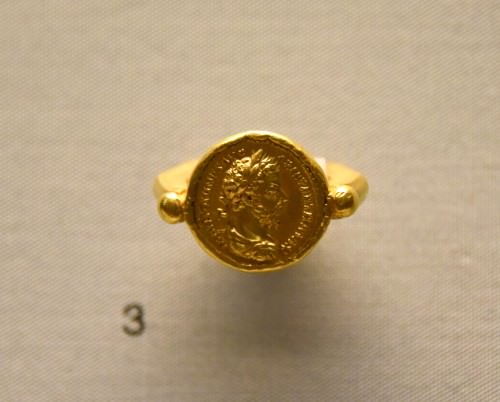
Gold ring with Coin of Emperor Marcus Aurelius
Epictetus (lc 50-130 CE) was the author of the Discourses and Enchiridion, famous lectures on Stoic principles and practice and the logos was the binding force in the universe which caused all things to be and kept all running harmoniously. If one concentrated one's focus on the logos, the Stoics claimed, one could live peacefully because one would realize that everything which happens is natural; it is only one's interpretation of an event which makes it “good” or “bad”.
Although Fronto strongly objects to Aurelius' interest in Stoicism in his letters, his former student embraced the philosophy fully and would put the principles he learned from his teachers into effect once he came to power.
AURELIUS THE EMPEROR
In March of 161 CE, Antoninus Pius died and the senate looked to Aurelius as the new emperor; in keeping with Hadrian's original designs, however, Aurelius refused the honor unless Lucius Verus was elevated as co-emperor with him. His request was granted and Aurelius and Verus began their reign by instituting programs to help the poor and rewarding the military with more pay and greater honor. They encouraged free speech, the arts, education, and boosted the economy – at least for a time – by debasing the currency; the two emperors quickly became immensely popular with the people.
Aurelius continued to hold fast to his Stoic principles as emperor but Verus, who had always been more extravagant, indulged himself through lavish parties and expensive gifts to friends. The Historia Augusta records one such “especially notorious” party at which Verus gave out “ gold, silver, and gemmed bowls…golden vases in the shape of perfume boxes…carriages with silver harnesses” as well as many more luxuriant gifts and the entry concludes, “the cost of this dinner party has been estimated as six million sestertii [around $60 million]. When Marcus heard about this party he is said to have groaned and wept for the fate of the world” (Harvey, 280).

Marcus Aurelius
In late 161 CE, the Parthian king Vologases IV (r. 147-191 CE) invaded Armenia, which was under Rome's protection, and the Roman province of Syria revolted. Verus had more military experience than Aurelius and so took charge of the campaigns in the east personally. It is also thought that Aurelius may have manipulated Verus into going to curtail his extravagant parties.The Parthian Wars would last until 166 CE and concluded with a Roman victory. This success was due not so much to Verus but to the general Gaius Avidius Cassius (l. 130-175 CE) who brilliantly deployed the troops and devised the tactics.
While Verus was away on campaign, Aurelius remained at Rome and, by all accounts, performed his duties with distinction. He adjudicated court cases, reviewed and passed laws which benefited all the classes of Rome, and dealt with the various requests and difficulties that came in from the provinces. It is also during this time (c.162-c.166 CE) that he persecuted the new sect of Christianity which refused to honor the state religion and disrupted the social order. Although these persecutions were later condemned once Christianity triumphed, at the time they would have been considered necessary in keeping the peace.
MARCUS AURELIUS REMAINED FAITHFUL TO HIS VISION OF A WORLD GOVERNED BY A NATURAL, & BENIGN, INTELLIGENCE WHICH RAN THROUGH ALL THINGS.
By 166 CE, the Christian problem seemed to be resolved and it looked as though the war with Parthia would be won. Aurelius had married Faustina in 145 CE and they had a number of children over the years. Even though some of these died young, Aurelius still had every reason to believe the gods could be smiling upon him with good fortune.
As the Parthian war concluded, however, the Marcomanni tribe of Germania invaded Roman provinces on the Danube in an alliance with the Persian Sarmatians. In 167 CE, Aurelius joined Verus in the field to drive back these invasions and restore order. It is possible, even likely, that Aurelius was advised in his campaign by the experienced military leader and consulMarcus Nonius Macrinus (dc 171 CE), whose early career and close relationship with Aurelius inspired aspects of the character of Maximus Decimus Meridius in the film Gladiator.
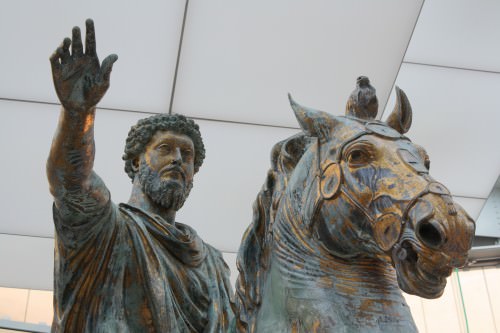
Marcus Aurelius
In 169 CE, Verus died – most likely of the plague his troops had brought back to Rome from campaign – and Aurelius ruled alone. He would devote most of his remaining reign to campaigns in Germania where he would write his Meditations.
THE MEDITATIONS
Aurelius' Meditations is his true legacy to the world, far out-stripping any achievements of his reign, however notable they may have been. The work is a private journal of the emperor's thoughts written to encourage himself in living the best life possible.Scholar Gregory Hays comments:
The questions that the Meditations tries to answer are primarily metaphysical and ethical ones: Why are we here? How should we live our lives? How can we ensure that we do what is right? How can we protect ourselves against the stresses and pressures of daily life? How should we deal with pain and misfortune? How can we live with the knowledge that someday we will no longer exist? (xxiv-xxv)
The Meditations is far from a philosophical treatise, however; it is one man's thoughts on life and the struggle to remain at peace with one's self in a world which constantly threatens such peace. Aurelius' answer to the problem is not an answer but a course of discipline in denying one's self the luxury of self-pity. In accordance with the Stoic view, everything that happens in life is natural – sickness/health, satisfaction/disappointment, joy/sadness, even death – and it is only one's interpretation of events which can trouble a person. The logos, which controls all things, controls one's fate as well but, even so, a human being still has the freedom to choose how to respond to circumstance. Hays elaborates:
According to this theory, man is like a dog tied to a moving wagon. If the dog refuses to run along with the wagon he will be dragged by it, yet the choice remains his: to run or be dragged. (xix)
The universe, to Aurelius and the Stoics, is good and only has the best intentions for humanity; it is an individual's choice to interpret those intentions correctly and find peace or to choose to cling to one's impressions and suffer. Aurelius writes:
If it is good to you, O Universe, it is good to me. Your harmony is mine. Whatever time you choose is the right time. Not late, not early. What the turn of your seasons brings me falls like ripe fruit. All things are born from you, exist in you, return to you. (IV.23)
Although he would lose children, friends, and even his wife, Aurelius remained faithful to this vision of a world governed by a natural, and benign, intelligence which ran through all things, bound all things together, and dispersed all things in time. There was, then, no concept of tragedy in Aurelius' philosophy because everything that happened was a natural occurrence and nothing in nature could be interpreted as tragic. He writes:
Fear of death is fear of what we may experience: nothing at all or something quite new. But if we experience nothing, we can experience nothing bad. And if our experience changes, then our existence changes with it – change, but not cease. (IV.58)
DEATH & LEGACY
Between 170-180 CE, Marcus Aurelius campaigned against the Germanic tribes and toured the eastern provinces of his empire. In 175 CE, his general Cassius rebelled in Syria, proclaiming himself emperor, before he was assassinated by a subordinate. Faustina accompanied Aurelius on campaigns 170-175 CE and went with him to Syria, Egypt, and Greece. She died in the winter of 175 CE.
In 178 CE, Aurelius defeated the Germanic tribes on the Danube and retired to winter quarters at Vindobona. He would die there two years later in March of 180 CE and was succeeded by Commodus. Although he had tried to groom his son in the same steady way that Antoninus Pius had him, he seems to have realized that he had failed. Commodus' self -indulgence and cruelty marked a reign which could not have been more different from his father's and proved true another of Aurelius' maxims from his Meditations IV.57: “What does not transmit light creates its own darkness.”
What happened to the Meditations after Aurelius' death is unknown but they somehow survived and copies were made and preserved. The text is mentioned in the 4th century CE by the orator Themistius (Hays, xliv) and in the Historia Augusta. No further mention of it is made until the 10th century CE when the cleric Arethas mentions copying it in a letter to a friend.
Arethas' copy may be responsible for preserving Meditations which is thought to have been among the books rescued from the library of Constantinople in 1453 CE when the city fell to the Ottoman Turks. These books were carried west where they were copied and, by 1559 CE, the first printed edition of the work was available. It has long since become a source of inspiration for people around the world who know Aurelius first as a philosopher and only second as an emperor; which is probably how Marcus Aurelius himself would have wanted it.
Vagharshapat › Origins
Definition and Origins
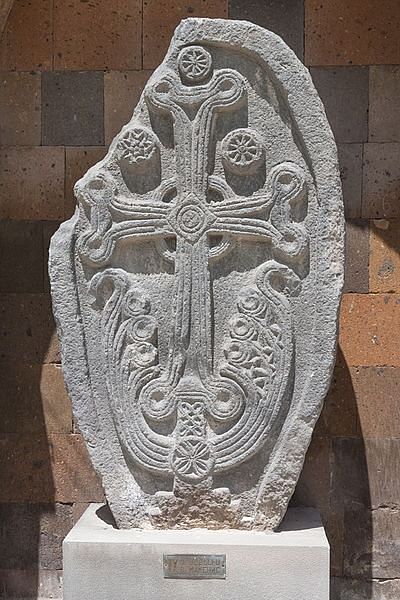
Vagharshapat (Valarsapat), located some 20 km west of modern Yerevan, was an ancient city in Armenia founded in the 2nd century CE. Serving as the capital, the city prospered and, under the new name of Echmiadzin, became the spiritual capital of Christian Armenia from the 4th century CE. Still an important pilgrimage site today, the building of the cathedral at Vagharshapat is attributed to Saint Gregory the Illuminator who was, in a vision, instructed by Christ to build it there after he descended and struck the ground at the very spot. The site is listed by UNESCO as a World Heritage Site.
THE ROYAL RESIDENCE
Vagharshapat was founded during the reign of the Arsacid king Vagharsh I (r. 117-140 CE), who gave his name to the new city, a common practice of the period. Artashat (Artaxata) remained the capital but Vagharshapat became the royal residence. The city was not entirely built from scratch but expanded upon the existing settlement of Vardgesavan. The city was protected by a new and encircling fortification wall.
In 166 CE Vagharshapat became the first city in Armenia following the sack of Artashat by a Roman army led by Statius Priscus. The Roman and Persian Empires had been constantly bickering over control of Armenia for its vital strategic value in the region. Priscus established a Roman garrison at Vagharshapat, and the city, known to them by its Greek name, Kaine Polis or New City, was made the new administrative capital, a position it kept even after Artashat was rebuilt a few years later.Vagharshapat was attacked and destroyed during the Sasanid invasions of 368 and 369 CE. The city was then replaced as the political capital by Dvin sometime in the 4th century CE.
IN THE LATTER HALF OF THE 4TH CENTURY CE THE SEAT OF THE FIRST BISHOP OF ARMENIA, THE KATHOLIKOS, WAS MOVED FROM ARTASHAT TO VAGHARSHAPAT.
The move of the political capital to Dvin was designed to disassociate the new regime from that of the former Armenian ruling dynasty the Arsacid dynasty (12 CE - 428 CE) and increase loyalty to Persia, which now controlled that part of Armenia. A Persian viceroy or marzpan had his palace at Dvin but Vagharshapat was not about to be consigned to obscurity for it became the religious capital of Armenia under the new name of Echmiadzin (aka Etchmiadzin or Edjmiadsin).
A RELIGIOUS CAPITAL: ECHMIADZIN
During the reign of Tiridates the Great (rc 298 - 330 CE) Christianity was formally adopted as the state religion of Armenia, and the king himself was said to have been converted in 301 CE by Saint Gregory the Illuminator in the royal palace at Vagharshapat. Some of the earliest churches in the country were built in the city. In the latter half of the 4th century CE the seat of the first bishop of Armenia, the katholikos, was moved from Artashat to Vagharshapat (it would later be moved again, this time to Dvin). This is traditionally seen as the work of the katholikos Sahak (r. 387-428 CE). The city became a focal point from which the tentacles of the Armenian Apostolic Church spread out to convert the entire country. The famed clergyman and scholar Mesrop Mashtots (360/370 - c. 440 CE), who invented the Armenian alphabet, resided here.

Arsacid Armenia
One of the most tangible and long-lasting manifestations of Vagharshapat's roles as the spiritual centre of Armenia was, and is, the great cathedral dedicated to the Mother of God. Said to have been built by Saint Gregory following a vision in which Christ descended to earth and indicated the very spot, the cathedral thus explains the city's new name of Echmiadzin, meaning “The Only-Begotten-One Descended”. Archaeological evidence suggests that the cathedral was built, no doubt intentionally, on the site of a pagan fire altar, as revealed by archaeological excavations in 1957 CE. The version of the cathedral which stands at the site today dates to 483 CE after the then ruler Vahan Mamikonian commissioned an upgrade on Saint Gregory's first structure. The cathedral was a compensation, perhaps, for the moving of the church's headquarters to Dvin in 485 CE.
A PILGRIMAGE SITE
Another 5th-century CE addition to the city's Christian architecture was a monastery with its first prior being the famous scholar and historian Ghazar Parpetsi. In time, the monastery accumulated an impressive manuscript library. Over the following two centuries, successive bishops ensured the building programme continued. In the 7th century CE, under the guidance of the bishop Komitas of Aghdzk (r. 615-628 CE), Echmiadzin began to pull in even more pilgrims following the construction of the particularly splendid church of Saint Hripsime which was named after the virgin who had been martyred by Tiridates the Great prior to his conversion to Christianity. Indeed, the church was said to have been built on the very spot of Hripsime's death. The church of Saint Gayane was added around 616 CE and, in the 650s CE, the completion of the impressive Zvartnots cathedral nearby only added to the attractions which ensured Echmiadzin became one of the most important pilgrimage sites in Armenia.

Saint Hripsime Church Façade
LATER HISTORY
Following the invasion and occupation of Armenia by the Umayyad Caliphate from 640 CE the position of Echmiadzin as a major religious centre became precarious. Dvin and then Ani were the political and religious capitals, and Echmiadzin slowly fell into decline. A major earthquake struck the region in the 10th century CE which caused the collapse of the church of Zvartnots, amongst other buildings. By the late 13th century CE the site was so dilapidated that the celebrated poet Stepanos Orbelian (d. 1304 CE) felt compelled to compose his Lamentations on the Holy Cathedral of Vagharshapat.
Echmiadzin's fortunes revived when the Armenian church decided to restore the catholicosate to the site in the mid-15th century CE. The country and its Christians endured troubled times under Turkish rule but Echmiadzin's monastery was given certain economic privileges which at least ensured the site could maintain itself until better days arrived. These days did come but not until the late 18th century CE. It was then that the bishop Simon of Yerevan (r. 1763-1780 CE) embarked on an ambitious plan to make the site a great centre of learning, aided by generous donations from Armenians abroad, especially in India. The process began with the installation of Armenia's first printing press and a paper mill to keep it well-supplied with raw material, a new archive was established for the Armenian church's records, and a general rebuilding programme was initiated which included a new cupola and three new belfries for the cathedral. After surviving the anti-religious Soviet regime of the 20th century CE, present-day Echmiadzin has once more become a major pilgrimage centre and tourist attraction for its excellent surviving examples of Armenian medieval architecture.
Queen of Sheba › Who Was
Definition and Origins
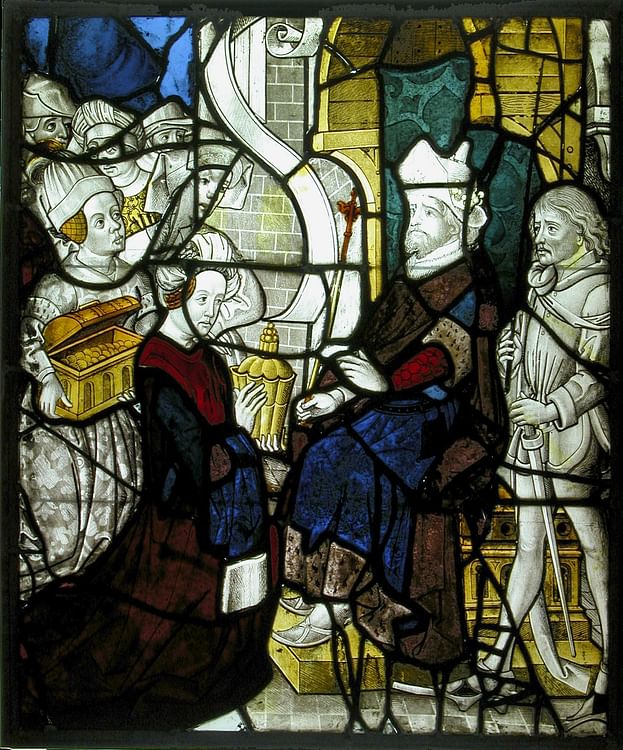
The Queen of Sheba is the monarch mentioned in the Bible and then in later works who travels to Jerusalem to experience the wisdom of King Solomon (c. 970-931 BCE) of Israel first-hand. The queen is first mentioned in I Kings 10:1-13 and in II Chronicles 9:1-12 in the Bible, then in the later Aramaic Targum Sheni, then the Quran, and finally the Ethiopian work known as the Kebra Negast ; later writings featuring the queen, all religious in nature, come basically from the story as first told in the Bible. There is no archaeological evidence, inscription, or statuary supporting her existence outside of these texts.
The region of Sheba in the Bible has been identified as the Kingdom of Saba (also sometimes referred to as Sheba) in southern Arabia but also with Ethiopia in East Africa. In the biblical tale, the queen brings Solomon lavish gifts and praises his wisdom and kingdom before returning to her country. Precisely where she returned to, however, is still debated as the historian Flavius Josephus (37-100 CE) famously identified her as a queen of Ethiopia and Egypt but the probable (and most commonly accepted) dates for Solomon argue in favor of a monarch from southern Arabia; even though no such monarch is listed as reigning at that time.
ETHIOPIA OR ARABIA
The debate concerning whether the queen came from Ethiopia or Arabia has been going on for centuries and will no doubt continue, even though there is no hard evidence said queen even existed. Those who argue for an Ethiopian queen claim that she reigned over the Kingdom of Axum; but Axum did not exist during the reign of Solomon nor even when the Book of Kings was composed (c. 7th/6th century BCE). Axum only existed as a political entity c. 100 - c. 950 CE. It supplanted or evolved from an earlier kingdom known as D'mt which was influenced by the Sabean culture of southern Arabia.
THE DEBATE CONCERNING WHETHER THE QUEEN CAME FROM ETHIOPIA OR ARABIA HAS BEEN GOING ON FOR CENTURIES, EVEN THOUGH THERE IS NO HARD EVIDENCE SAID QUEEN EVEN EXISTED.
D'mt flourished between the 10th and 5th centuries BCE from its capital at Yeha but little else is known about the culture.Sabean influence is evident in the temple to the moon-god Almaqah, the most powerful Sabean deity, which still stands.Scholars are divided on how much the Sabeans influenced the culture of D'mt but the existence of the temple and linguistic similarities indicate a significant Sabean presence in D'mt.
This should not be surprising since Saba was a growing power c. 950 BCE and the wealthiest kingdom in southern Arabia c.8th century BCE through 275 CE when it fell to the invading Himyarites. Whether D'mt was originally a Sabean colony is disputed, and the claim has largely been discredited but the proximity of the two kingdoms and obvious Sabean presence in D'mt suggest a close interaction. Saba was the trading hub in southern Arabia for the Incense Routes, and it would certainly make sense for them to have established friendly relations, if not a colony, just across the Red Sea.
It is possible, then, that the Queen of Sheba was a Sabean ruler of D'mt and that her legend then became associated with Ethiopia by the time Flavius Josephus was writing. It is more probable, however, that the association of Saba with D'mt led later historians, including Josephus, to claim she journeyed from Ethiopia when she actually came from Arabia. There is also, of course, the probability that she never journeyed from anywhere to anywhere because she never existed but the persistence of her legend argues for an actual historical figure.
THE QUEEN IN THE BIBLE
The Books of I Kings and II Chronicles relates the story of the queen's visit, and it is upon these works (or whatever sources the author of Kings worked from) that later versions of the story are based. According to the biblical tale, once Solomon became king he asked his god for wisdom in ruling his people (I Kings 3:6-9). God was pleased with this request and granted it but also added riches and honor to the king's name which made Solomon famous far beyond his borders.
The queen of Sheba heard of Solomon's great wisdom and the glory of his kingdom and doubted the reports; she, therefore, traveled to Jerusalem to experience it for herself. The Bible only states that the monarch is “the queen of Sheba” (I Kings 10:1) but never specifies where “Sheba” is. Her purpose in coming to see the king was “to prove him with hard questions” (I Kings 10:1) and, once he had answered them and shown her his wisdom, she presented Solomon with lavish gifts:
And she gave the king a hundred and twenty talents of gold, and of spices very great store, and precious stones: there came no more such abundance of spices as these which the queen of Sheba gave to Solomon. (I Kings 10:10)
The 120 gold talents would amount to approximately $3,600,000.00 in the present day and this kind of disposable wealth would certainly be in keeping with the affluence of the Sabean monarchy though not necessarily during Solomon's reign. The mention of the great amount of gold and, especially, the “abundance of spices” certainly suggest Saba, whose main source of wealth was the spice trade, but evidence suggests Saba was most prosperous only from the 8th century BCE onward.

Two Riddles of the Queen of Sheba
After giving Solomon these gifts, the queen then receives from him “all her desire, whatsoever she asked, besides that which Solomon gave her of his royal bounty” and then returns to her country with her servants (I Kings 10:13). Following her departure, the narrative details what Solomon did with her gifts and with the almug trees and gold which Hiram of Tyre had brought him from the land of O'phir (I Kings 10:11-12, 14-26). Nothing further is mentioned of the queen in I Kings and her appearance in II Chronicles 9:1-12 follows this same narrative.
THE TARGUM SHENI VERSION
By the time the story is repeated in the Targum Sheni, however, it has expanded with significantly more detail. The Targum Sheni is an Aramaic translation of the biblical Book of Esther with commentary but includes the story of the Queen of Sheba as one of its ancillary tales. This version takes the biblical tale of the queen's visit and embellishes it with touches of mythologywhich most likely had grown up around the figure of Solomon. Solomon's wisdom, according to the Bible, enabled him to understand the language of the trees, animals, and birds (I Kings 4:33). The Targum Sheni picks up on this thread and begins its story with Solomon inviting all the birds and animals of his kingdom to a great feast.
The creatures all gratefully accept the invitation except for the woodcock who declines, pointing out that Solomon is not as great a monarch as the Queen of Sheba and so does not deserve this level of respect. Solomon then invites the queen to his palace to do homage to him and prove the woodcock wrong and, in order to make a greater impression on her, has one of the spirits under his command transport the queen's throne to him. When the queen arrives she is suitably impressed, walking across a floor of glass which seems water, but still tests Solomon by asking him difficult riddles which, through his wisdom, he is able to answer; the queen then pays him homage, and presumably, the woodcock is satisfied.
The Targum Sheni comes from the genre of rabbinic literature known as the midrash: commentaries and interpretation of scripture. The work has been dated to between the 4th-11th centuries CE with different scholars arguing for an earlier or later date based on textual clues. This debate, like the one surrounding the queen's country of origin, continues but it seems likely that the Quran borrows the story from the Targum Sheni since the Islamic work regularly makes use of other older material. To cite only one such example, the Greek story of the Seven Sleepers of Ephesus appears in a revised form in Sura 18. Like the tale of the Seven Sleepers, the story of the queen of Sheba changes in the Quran to fit the overall vision of the work.
THE QUEEN IN THE QURAN
In the Quran, the queen is known as Bilqis and rules over the mighty kingdom of Sheba. In this version of the story, as in the Bible, Solomon (given as Sulayman) is given the gift of the speech of birds, animals, and the spiritual entities known as jinn(genies). He assembles his hosts one day to inspect them but does not find the hoopoe bird among the company. Solomon says:
How is it with me that I do not see the hoopoe? Or is he among the absent? Assuredly I will chastise him with a terrible chastisement, or I will slaughter him, unless he bring me a clear authority [provide a good excuse]. (Sura 27:20)
The hoopoe bird appears and tells Solomon that he has been flying far and came to the land of Sheba where, he says, “I found a woman ruling over them and she has been given of everything and she possesses a mighty throne” (Sura 27:20). The bird then goes on to say how the people of Sheba worship the sun, not the god of Solomon, Allah, and how Satan has led them astray so that, although they have a great kingdom, they “are not guided, so that they prostrate not themselves to God” (Sura 27:25). Solomon forgives the bird his earlier absence and sends him with a letter to the queen, inviting her to visit his kingdom.
When the queen receives the letter, she calls a council and reads aloud how Solomon wishes her to come to him in submission to his god. She asks the council for advice, and they tell her they are ready to fight for her but the decision must finally be hers. She decides to send Solomon a gift through a messenger, but the king rejects it and tells the messenger that, unless the queen complies, he will “come against them with hosts they have not power to resist and we shall expel them from there, abased and utterly humbled” (Sura 27:35). After the messenger leaves, Solomon remembers what the hoopoe bird said about the queen's throne and asks his council-members who among them can bring him the royal seat before the queen arrives. A jinn assures him it can be done and brings him the throne.

King Solomon and the Hoopoe
Once the throne is installed in a pavilion made of crystal, Solomon disguises it. When the queen arrives, he asks her if it is her throne and she replies that it seems to be the same. She is then told to enter the pavilion where she bares her legs before stepping onto the floor because it is so clear she thinks it is water. The wonder of the crystal pavilion and the appearance of her own throne there overwhelms the queen, and she says, “My lord, indeed I have wronged myself and I surrender with Solomon to God, the Lord of all Being” (Sura 27:45). Once the queen has submitted to Solomon's god the narrative in the Quran ends but Islamic tradition and legend suggests that she married Solomon.
THE KEBRA NEGAST VERSION
In the Kebra Negast (“The Glory of Kings”) of Ethiopia this story is retold but developed further. Here, the queen's name is Makeda, ruler of Ethiopia, who is told of the wonders of Jerusalem under Solomon's reign by a merchant named Tamrin.Tamrin has been part of an expedition to Jerusalem supplying material from Ethiopia for the construction of Solomon's temple.He tells his queen that Solomon is the wisest man in the world and that Jerusalem is the most magnificent city he has ever seen.
Intrigued, Makeda decides to go visit Solomon. She gives him gifts and is given gifts in return and the two spend hours in conversation. Toward the end of their time together, Makeda accepts Solomon's god and converts to Judaism. Solomon commands a great feast to celebrate Makeda's visit before her departure, and she spends the night in the palace. Solomon swears an oath that he will not touch her as long as she does not steal from him.
Makeda agrees but, in the night, becomes thirsty and finds a bowl of water which Solomon has placed in the center of the room. She is drinking the water when Solomon appears and reminds her that she swore she would not steal and yet here she is drinking his water without permission. Makeda tells him he can sleep with her since she has broken her oath.

Solomon and the Queen of Sheba
Before she leaves Jerusalem, Solomon gives her his ring to remember him by and, on her journey home, she gives birth to a son whom she names Menilek (“son of the wise man”). When Menilek grows up and asks who his father is, Makeda gives him Solomon's ring and tells him to go find his father.
Menilek is welcomed by Solomon and stays in Jerusalem for some years studying the Torah. In time, however, he must leave and Solomon decrees that the first-born sons of his nobles will accompany Menilek back home (possibly because the nobles had suggested Menilek should leave). Before the group departs, one of the sons of the nobles steals the ark of the covenant from the temple and replaces it with a duplicate; as the caravan leaves Jerusalem, the ark goes with them.
The theft of the ark is discovered soon after, and Solomon orders his troops to pursue but they cannot catch up. Menilek, meanwhile, has discovered the theft and wants to return the ark but is persuaded that this is the will of God and the ark is supposed to travel to Ethiopia. In a dream, Solomon is also told that it is God's will the ark was taken and so calls off his pursuit and tells his priests and nobles to cover up the theft and pretend the ark in the temple is the real one. Menilek returns to his mother in Ethiopia with the ark which is enshrined in a temple and, according to legend, remains there to the present day.
CONCLUSION
There are other later sources which also feature the mysterious queen and argue for or against her historicity. The Christian canticles of the Middle Ages, drawing on the New Testament references to a “Queen of the South” as the Queen of Sheba (Matthew 12:42 and Luke 11:31), represented her as a mystical figure. Christian art of the Middle Ages and Renaissance often chose the queen as a subject depicted either alone or in the company of Solomon.
The Talmud claims that there never was such a queen and that the reference to a queen in I Kings is meant to be understood figuratively: the “queen of Sheba” should be understood to mean the “kingdom of Sheba”, not an actual person (Bava Batra 15b). Other traditions seem to indicate there was such a queen but who she was and where she came from remains a mystery.
There is no reason to question the claim that a diplomatic mission may have been sent from Saba to Jerusalem during the reign of Solomon and that the emissary would have been a woman. The queen could have been the daughter of one of the Sabean kings or perhaps ruled on her own after the death of her husband.
There is, as noted, no record of a queen of Saba but neither is there any indication of a queen of Sheba named Makeda in Ethiopia or any record of a queen name Bilqis outside of the Quran. Historically, the Queen of Sheba remains a mystery but her legend has endured for millennia and she continues to inspire literature and art in her honor in the present day.
LICENSE:
Article based on information obtained from these sources:with permission from the Website Ancient History Encyclopedia
Content is available under License Creative Commons: Attribution-NonCommercial-ShareAlike 3.0 Unported. CC-BY-NC-SA License